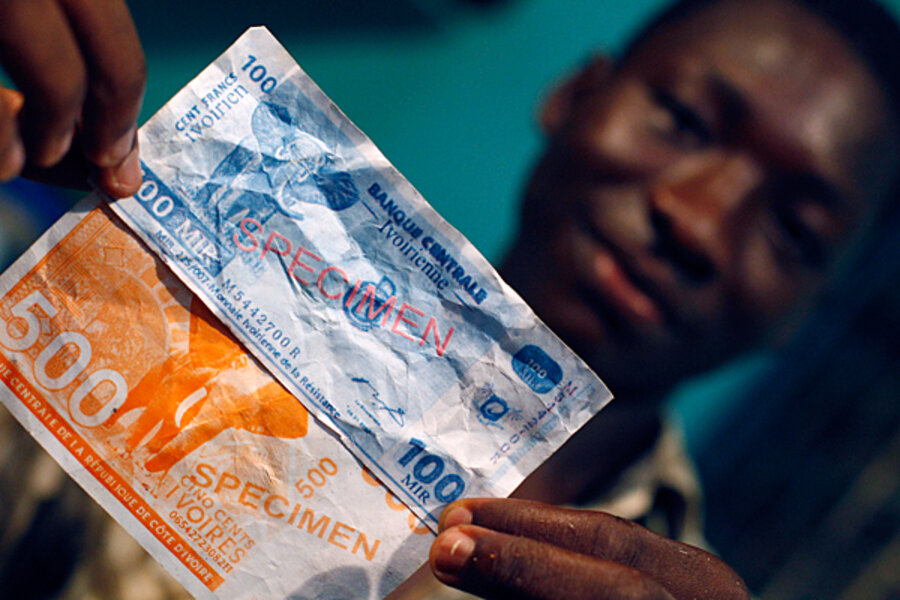Africa's single currency, the CFA Franc, in a Post-euro Future
Loading...
Born only thirteen years ago, there are credible concerns that the euro won’t make it through adolescence. Just last week, the currency hit a sixteen-month low against the dollar while Standard and Poor’s downgraded the credit ratings of nine eurozone countries including France. In contrast, France’s former colonies in western and central Africa have developed a common currency that works. Indeed, the CFA franc has survived for more than sixty years.
The question now is, what will happen to the CFA zone as the euro crisis deepens?
Fourteen countries use one of two euro-pegged CFA (commonly pronounced “say-fah”) francs as their legal tender. Comprised of eight agrarian West African nations and six resource-rich central African countries, the combined monetary zone stretches from Senegal on Africa’s western coast to the Central African Republic (CAR) at the heart of the continent.
Like the European Union (EU), the CFA zone is economically, politically, and culturally diverse. It encompasses 123 million people, hundreds of languages, and a patchwork of ethnic groups. These countries also have by no means escaped the political tumult that has plagued so much of Africa. CAR alone has been hit with nine coups since it gained independence in 1960. And yet, the region’s essential monetary infrastructure remains.
Some might credit the legacy of French colonial rule for keeping the CFA together, given Paris’s backing of the currency and guaranteeing of the euro exchange rate. This peg undoubtedly garners benefits for the CFA (e.g., lower transaction costs in trading with EU countries), but its fate is not intrinsically tied to the euro.
If the euro collapses, the CFA zone wouldn’t tie itself to a resurrected French franc but likely peg to a basket of currencies. Low-growth Europe is no longer the prominent destination for CFA goods, rendering the euro peg less and less important. In 1995, approximately 49 percent of exports from the central African CFA countries were bound for Europe. By 2010, that number had dropped to an estimated 32 percent.
China’s rise as an export destination is most responsible for the turn away from Europe. It has an insatiable demand for natural resources, which makes African countries attractive trading partners. The growing strength of the Chinese renmimbi against the euro hasn’t hurt either.
A euro collapse and subsequent devaluation of the CFA could in fact boost the zone’s long-term competitiveness. When the CFA was devalued by 50 percent in 1994, an International Monetary Fund study found that the zone “experienced strong economic expansion, a more balanced macroeconomic performance, and progress in transforming the structure of their economies.” (Ironically, devaluation against the euro is precisely the policy that might help countries like Greece and Italy today, but they are politically bound to their fixed exchange rate.)
This is not to say de-pegging and devaluation would be all gain and no loss. Without the backing of the French Treasury, including the mandatory reserve balances, the CFA zone would no longer have the immediate credibility and resources that keep international investors relatively at ease with investments in a highly-indebted poor country region. But the euro’s continued fall against the dollar signals that investors seem to be losing confidence in the euro itself.
And, while boosting CFA zone exports, devaluation also comes at the expense of making imports into Africa more expensive. Oil exporters will benefit while harming crude oil importers and consumers of foreign goods and services in general. For the most part, however, only a small segment of those in the CFA zone consume these goods and services given their relatively high costs. Beyond its economic role, the CFA zone has also shown to be useful in mitigating conflicts. A prime example being Ivory Coast’s 2010-11 elections crisis in which the incumbent president Laurent Gbagbo refused to step down. The West African central bank shut down Gbagbo’s access to the country’s reserves, cutting off his resources to buy the loyalty of civil servants and security forces.
Perhaps seeing the CFA’s success, the East African Community (EAC)—the regional economic body comprised of Uganda, Kenya, Rwanda, Tanzania, and Burundi—has moved toward creating its own common currency. Progress has been halting but the countries will likely soon cede customs authority to the EAC and are hammering out a deal to stand up a monetary union centered around the envisaged “East African Central Bank.”
Anglophone West Africa, for its part, also seems intent on creating a common currency. Six countries in the well-integrated regional body ECOWAS are working to establish “the Eco” by the end of the decade. It aims to merge eventually with the CFA, which would create the largest monetary zone in the world (by number of countries).
While the EAC and ECOWAS should continue their push toward monetary integration, they also must recognize that a common currency alone will not solve their economic challenges. Despite the CFA’s success, cross-border capital controls are tight, labor remains relatively immobile, and intra-zone trade growth has been minimal. In essence, having a single currency is an important piece of the economic pie, but it’s not the whole pie.
Originally, the fixed exchange rate regime was a tool of French imperial policy, providing the African colonies a stable currency with guaranteed convertibility in their largest export market. Despite coups, civil wars, devaluations, and even sovereign defaults, the CFA zone has persisted.
While the eurozone’s potential break-up threatens to end the monetary tie between France and its former colonies, the CFA zone will survive—and could very well thrive—without the euro.
Andrew C. Miller is a research associate at the Council on Foreign Relations’ (CFR) Center for Preventive Action. Neil Bouhan is an analyst at CFR’s Greenberg Center for Geoeconomic Studies.





